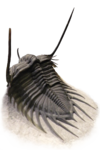| Calymene blumenbachii Temporal range: Wenlock
~ | |
|---|---|

| |
| Calymene blumenbachii, on display at the Natural History Museum, London | |
| Scientific classification | |
| Domain: | Eukaryota |
| Kingdom: | Animalia |
| Phylum: | Arthropoda |
| Class: | †Trilobita |
| Order: | †Phacopida |
| Family: | †Calymenidae |
| Genus: | †Calymene |
| Species: | †C. blumenbachii
|
| Binomial name | |
| †Calymene blumenbachii Brongniart in Desmarest, 1817
| |


Calymene Brongniart in Desmarest (1817),[1] sometimes erroneously spelled blumenbachi, is a species of trilobite discovered in the limestone quarries of the Wren's Nest in Dudley, England. Nicknamed the Dudley Bug or Dudley Locust[2] by 18th-century quarrymen it became a symbol of the town and featured on the Dudley County Borough Council coat-of-arms. Calymene blumenbachii is commonly found in Silurian rocks (422.5–427.5 million years ago) and is thought to have lived in the shallow waters of the Silurian, in low-energy reefs. This particular species of Calymene (a fairly common genus in the Ordovician-Silurian) is unique to the Wenlock series in England, and comes from the Wenlock Limestone Formation in Much Wenlock and the Wren's Nest in Dudley. These sites seem to yield trilobites more readily than any other areas on the Wenlock Edge, and the rock here is dark grey as opposed to yellowish or whitish as it appears on other parts of the Edge, just a few miles away, in Church Stretton and elsewhere. This suggests local changes in the environment in which the rock was deposited.
YouTube Encyclopedic
-
1/1Views:10 923
-
My favourite fossil: Richard Fortey (2/2)
Transcription
My name is Richard Fortey and for many years I was the trilobite expert at the Natural History Museum in London, and now I'm Emeritus but still have my office there. I'm going to tell you about my favourite trilobite, which is this specimen in this little leather bag. I was presented it. I was given it by Sir James Stubblefield, who was Director of the British Geological Survey and, in his day, a famous trilobite man. He died aged about 100 and, to my pleasure and surprise, I received this trilobite in his will, together with the story accompanying the trilobite, because Stubblefield himself had been left it by a man called Hawkins, who was a renowned authority on sea urchins in his day, and Hawkins had been in the First World War. Accompanying the specimen was a letter, now a bit faded, from the then keeper or head of Palaeontology in the Natural History Museum, to Hawkins. And Hawkins, at the time, was in the trenches in France in the First World War, and the letter went something as follows. "My dear Hawkins, I am thinking of you now in a very vulnerable position, and I wish I could present to you with armour to keep you safe, which I cannot. But I can send you the carapace of my favourite trilobite, and that's this one, Calymene blumenbachii, in the hope that it will keep you safe. And it did, because Hawkins came back and became a renowned professor and expert on sea urchins. And in his time, due time, Hawkins passed the trilobite onto Sir James Stubblefield, and Stubblefield eventually passed it on to me. So, it's a very precious object. And, well, I hope that it has a little charm attached to it because, a few years ago, I wrote a book called Trilobite! - with an exclamation mark - all about trilobites and how they live, and I was lucky enough to be picked to go on Start the Week with Jeremy Paxman, which, of course, always sets off a little flutter in your heart. And you get a few minute warm-up time before the programme, and I noticed that I was going to be with the famously acerbic novelist, Will Self, I was getting a bit worried and nervous. But I did have, in my pocket, my lucky charm, the trilobite, and just before going onto the programme, I took it out and I showed it to Jeremy Paxman saying, "you probably haven't seen a trilobite before." And he took some interest in it. And I noticed, as we were walking in, he took my book from the bottom of the pile and put it on the top of the pile. So, maybe the trilobite charm had worked once again, a century after the First World War.
References
- ^ Desmarest, A. G. 1817. Calymène. in: Nouveau Dictionnaire d'Histoire Naturelle, Nouvelle Edition, Tome 8, pp. 517 - 518.
- ^ Alex J. Chestnut. "Using morphometrics, phylogenetic systematics and parsimony analysis to gain insight into the evolutionary affinities of the Calymenidae Trilobita". OhioLINK ETD Center. Retrieved 21 August 2011.
External links
- Dudley County Borough Council coat-of-arms Archived 5 June 2009 at the Wayback Machine at Civic Heraldry
- Wren's Nest at bbc.co.uk
- Siveter, Derek J. "The type species of Calymene (Trilobita) from the Silurian of Dudley, England". Palaeontology. 28 (4): 783–792.
- Donald G. Mikulic & Joanne Kluessendorf, 2007: The legacy of the locust—Dudley and its famous trilobite Calymene blumenbachii. In: D. G. Mikulic, et al., editors. Fabulous Fossils, 300 years of worldwide research on trilobites. New York State Museum Bulletin 507, p. 141-170. https://web.archive.org/web/20140714172533/http://www.nysm.nysed.gov/staffpubs/docs/16439.pdf

